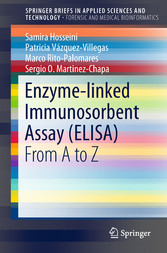Suche
Lesesoftware
Specials
Info / Kontakt
Enzyme-linked Immunosorbent Assay (ELISA) - From A to Z
von: Samira Hosseini, Patricia Vázquez-Villegas, Marco Rito-Palomares, Sergio O. Martinez-Chapa
Springer-Verlag, 2017
ISBN: 9789811067662 , 124 Seiten
Format: PDF, Online Lesen
Kopierschutz: Wasserzeichen




Preis: 64,19 EUR
eBook anfordern 
Preface
6
Acknowledgements
7
Contents
8
1 Fundamentals and History of ELISA: The Evolution of the Immunoassays Until Invention of ELISA
11
Abstract
11
1.1 Evolution of the Immunoassays Until Invention of ELISA
11
1.1.1 Side Chain Theory
11
1.1.2 Antigen-Antibody Binding Theory
12
1.1.3 Discovery of Antibody Structure
13
1.1.4 Invention of Radioimmunoassay (RIA)
13
1.1.5 Invention of Enzyme Linked Immunosorbent Assay (ELISA)
14
1.2 Principles of the Immune System
15
1.2.1 Antibody Production in Human Body
15
1.2.2 Different Types of Antibodies
15
1.2.2.1 Immunoglobulin G (IgG)
16
1.2.2.2 Immunoglobulin A (IgA)
17
1.2.2.3 Immunoglobulin M (IgM)
18
1.2.2.4 Immunoglobulin D (IgD)
19
1.2.2.5 Immunoglobulin E (IgE)
19
1.2.3 Antigen-Antibody Coupling
20
1.2.3.1 Specificity of the Antigen-Antibody Coupling
21
1.3 Biomolecular Interactions Between Antibody and Antigen
21
1.3.1 Hydrogen Bonding
21
1.3.2 Hydrophobic Interaction
22
1.3.3 Ionic Attraction
22
1.3.4 Van der Waals Forces
24
1.3.4.1 London Dispersion Force
24
1.3.4.2 Dipole-Dipole Interaction
24
1.3.4.3 Ion-Dipole Interaction
25
References
25
2 General Overviews on Applications of ELISA
29
Abstract
29
2.1 Applications of ELISA
29
2.1.1 Food Industry
29
2.1.2 Vaccine Development
30
2.1.3 Immunology
30
2.1.3.1 Autoimmunity
31
2.1.3.2 Humoral Immunity
31
2.1.4 Diagnosis
32
2.1.4.1 Pregnancy Test
32
2.1.4.2 Cancer Detection
33
2.1.4.3 Detection of the Infectious Diseases
33
2.1.5 Toxicology
34
2.1.6 Drug Monitoring and Pharmaceutical Industry
35
2.1.7 Transplantation
35
References
36
3 Step by Step with ELISA: Mechanism of Operation, Crucial Elements, Different Protocols, and Insights on Immobilization and Detection of Various Biomolecular Entities
40
Abstract
40
3.1 Mechanism of Operation
40
3.2 Different Elements of the Assay
42
3.2.1 Solid Phase
42
3.2.2 Adsorbents
42
3.2.2.1 Target Biomolecules
43
3.2.3 Washing Agents
43
3.2.4 Blocking Agents
43
3.2.5 Enzymes and Substrates
43
3.2.5.1 Different Types of Enzyme
46
3.2.5.2 Different Types of Substrate
48
3.2.6 Stopping Process
49
3.2.7 Reading Techniques
51
3.2.7.1 Colorimetric Assay
51
3.2.7.2 Fluorescent Assay
51
3.2.7.3 Luminescent Assay
52
3.2.8 Reading Apparatus
52
3.2.9 Controls
53
3.2.9.1 Positive Controls
53
3.2.9.2 Endogenous Positive Control
53
3.2.9.3 Negative Controls
53
3.2.9.4 Standard Controls
53
3.2.9.5 Spike Controls
53
3.3 Different Protocols
54
3.3.1 Direct ELISA
54
3.3.2 Indirect ELISA
54
3.3.3 Sandwich ELISA
54
3.3.4 Double Sandwich ELISA
56
3.3.5 Competitive ELISA
56
3.4 Initial Interaction of the Biomolecules with the Surface
56
3.5 Immobilization Techniques for Protein Attachment
58
3.5.1 Physical Immobilization
58
3.5.2 Immobilization via Entrapment
59
3.5.3 Covalent Immobilization
59
3.5.3.1 Immobilization via Zero-Length Cross Linker
60
3.5.3.2 Immobilization via Spacers
61
3.5.4 Oriented Immobilization
61
References
62
4 Evaluation of the Detection Results Obtained from ELISA
66
Abstract
66
4.1 Conducting a Reliable Assay
66
4.1.1 Sources of Errors
67
4.1.2 Troubleshooting
67
4.2 Key Parameters in ELISA Evaluation
71
4.2.1 Sensitivity
72
4.2.2 Specificity
72
4.2.3 Accuracy
72
4.2.4 Limit of Detection (LOD)
73
4.3 Measurable Units in ELISA
73
References
74
5 Advantages, Disadvantages and Modifications of Conventional ELISA
76
Abstract
76
5.1 Significance of Conventional ELISA
77
5.2 Shortages of Conventional ELISA
77
5.3 Materials of Choice for Fabrication of ELISA Well Plates
78
5.4 Different Types of ELISA Well Plates
79
5.5 Modified ELISA Platforms
80
5.5.1 ELISA on Coated Platforms
81
5.5.2 ELISpot
83
5.5.3 Plasmonic ELISA
85
5.5.4 Sphere-/Bead-Based ELISA
89
5.5.5 Paper-Based ELISA
93
5.5.6 Fiber-Based ELISA
99
5.5.7 ELISA in Micro-Devices
107
5.5.8 Other Strategies
114
5.5.8.1 Smart Devices in ELISA
114
5.5.8.2 Digital ELISA
116
5.5.8.3 Aptamers as Antibody Substitutes in ELISA
117
5.5.8.4 Multiple and Portable ELISA
117
References
117







